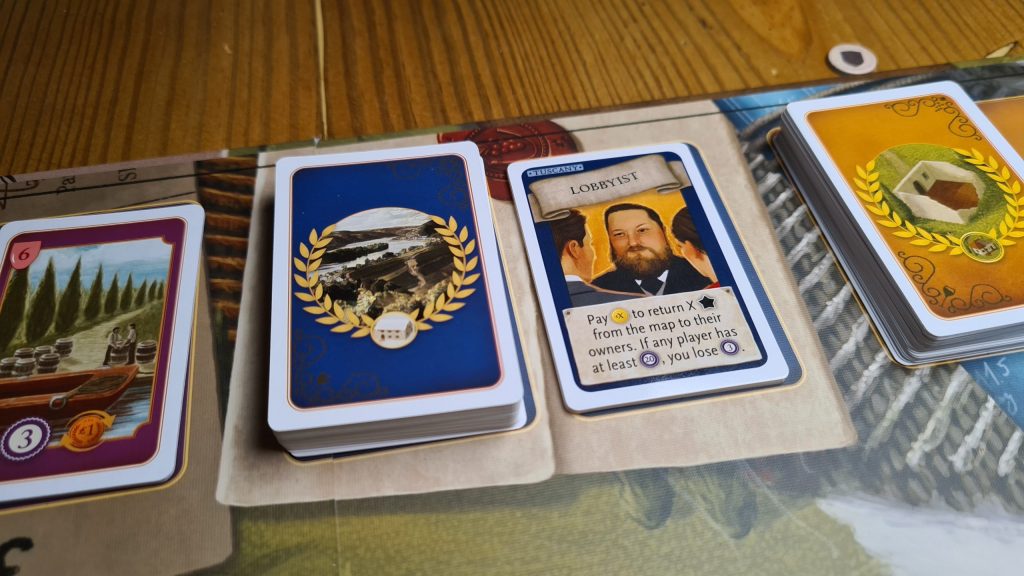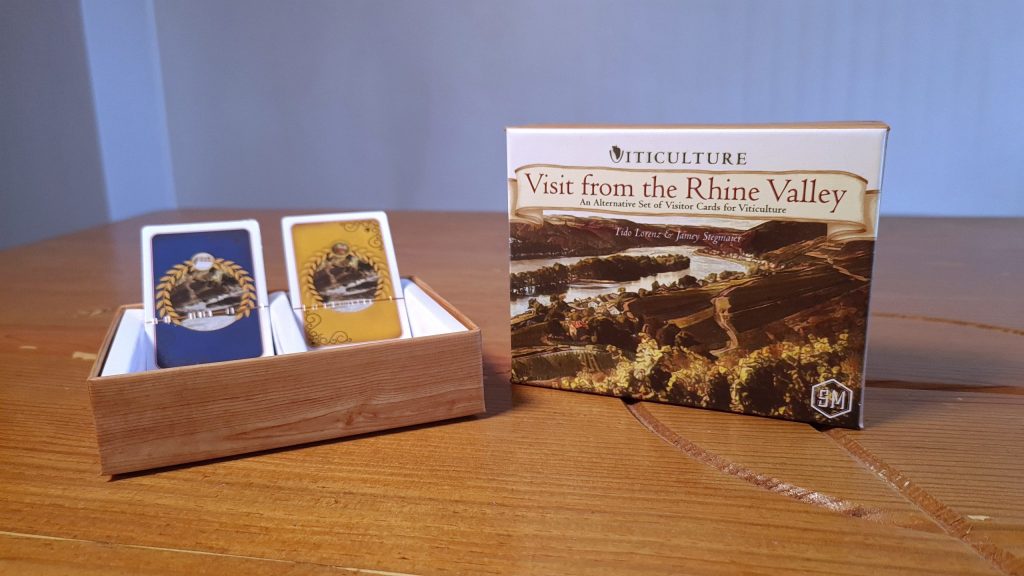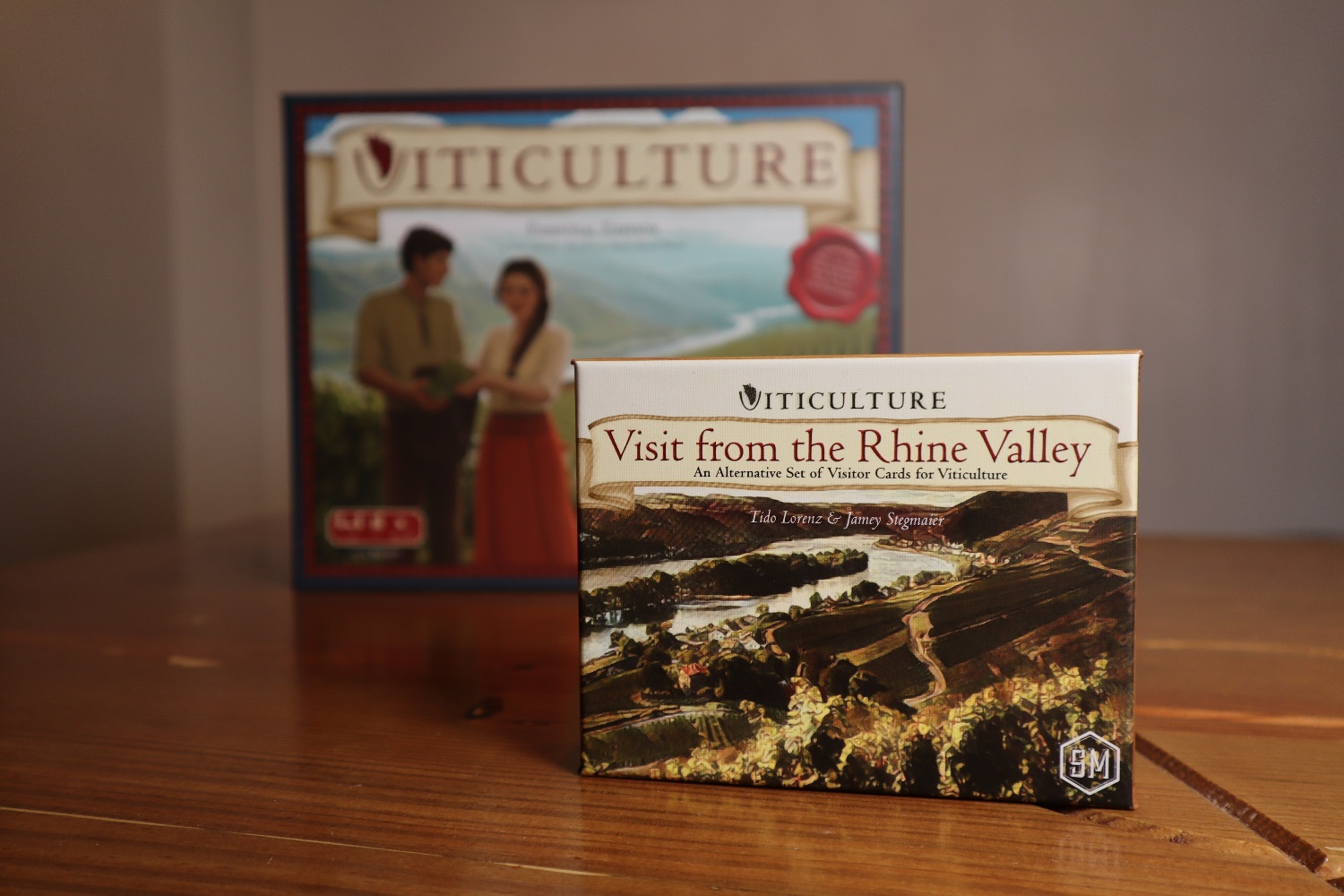Viticulture Visit from the Rhine Valley is the third expansion for the wine making themed, worker placement, board game from Stonemaier Games. Designed by Tido Lorenz and Jamey Stegmaier, featuring artwork from Beth Sobel, this small box expansion introduces new summer and winter visitor cards. The player count and the game length are unaffected by the expansion, which aims to put wine making firmly at the center of the game. However, will players want to use these visitors, or will they bottle it? Let’s find out!
Similar to the Moor Visitors expansion, Viticulture Visit from the Rhine Valley comes in a very small box. Included inside are 80 new summer and winter visitor cards, 40 of each. Unlike the Moor expansion, which shuffled into the base game decks, this expansion is a replacement for the original summer and winter visitor decks. The grape, wine fulfillment and, if playing Tuscany, the structure decks all remain unchanged.
While the new visitors aren’t less likely to offer ways to score points compared to the original deck of visitors, the scope of ways to score changes. While Tuscany and Moor Visitors opened up new avenues to score, outside of the wine making, the Rhine Valley visitors solidifies that core focus of the game. With opportunities to age grapes, fulfill wine orders and gain other cards, those that like that central focus will find plenty of helping hands. Conversely, those that liked to exploit opportunities surrounding the wine venture might find they need to rely less on the visitor decks to pull off a victory.

This expansion can be used with either the base game of Viticulture or with the Tuscany expansion. Of the 80 included cards only 4 are specific to the Tuscany expansion. These are neatly split to two from each season, so one deck isn’t smaller than the other. To make it simple to pull them out beforehand, or just instantly recognise them as for Tuscany when drawing visitor cards, these cards are marked with an icon. Three of these cards refer to the stars players can place on the map on the Tuscany board, while the other is about replacing a structure – both of which are only helpful when Tuscany is in play.
In the base game 38 summer and winter visitor cards are included, so with this expansion things are pretty much equal. However, this isn’t the case when you consider the Moor Visitors expansion pack, which players may already own and have shuffled into the original deck. Still, the variety is plentiful. In a two player game, with cottages built to draw additional visitor cards, in a single game around a third of the deck was seen. By not shuffling and putting the used cards to the bottom we therefore got about 3 games with no repetition. At this stage we’d only seen all of the cards but not used them, nor had we got to the level where we knew exactly everything that could come out of the deck.

So that the new decks can be easily distinguished from the original cards, the Rhine Valley sets have new artwork for the card backs. Featuring some of the box artwork is a nice touch, which sits within the laurel pattern which adorns the reverse of Viticulture cards. Thankfully, the backs are still mostly either yellow or blue – so all the iconography still makes sense. A lot of games these days seem to go for a linen finish. Keeping consistent with the cards of the original game the Visit from the Rhine Valley cards are definitely on the shiny side. Matching this style just helps this new deck feel like part of the game. Still, for a brand new expansion the cards may look a little too familiar to players. This is because the Visit from the Rhine Valley cards mostly feature reused art. With the deck replacing the original I can see why it’s been done, but it doesn’t feel any less like a shortcut on the development front. At the end of the day, gamers are paying for a set of new cards and not getting new artwork.
Viticulture Visit from the Rhine Valley, much like the Moor Visitors expansion, is for those that thoroughly enjoy Viticulture and want that spot of freshness. The game isn’t drastically changed, though routes to victory are slightly more focused to the central premise of growing grapes and fulfilling wine orders. Despite this shift the expansion won’t be changing anyone’s mind on the experience as a whole. Fans of Viticulture that get the game to the table regularly are the target audience. The opportunity to go back to a time where you don’t know what the visitors can do is a worthy experience, which is why Visit from the Rhine Valley is certainly staying in my collection!
(Editor’s Note: Viticulture Visit from the Rhine Valley was provided to us by Asmodee for the review. The expansion is currently available from local board game stores! Find your local store here.)

